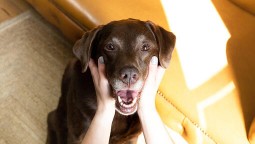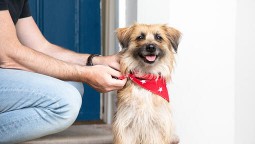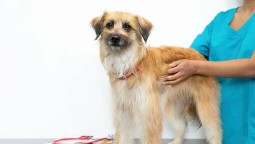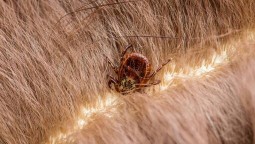Grooming your dog can be quite a challenge at times, but it doesn’t have to be. It is a good opportunity, not only to make your pet squeaky clean but also to bond and give them a quick health check to make sure everything is all right. Here are tips for how to groom your dog.
When it comes to our canine friends, grooming is often seen as a luxury, especially if you have to rely on regular visits to a professional pet groomer. But in most cases, grooming your dog doesn’t require any special skills and can be done at home with basic “equipment”. We’re not talking about hair makeovers or artistic pedicures. Just a few simple tasks that can become part of a grooming routine and will soon turn into a relaxing bonding experience for both of you.

As with anything, some pooches are happier to be groomed than others. Make sure to take it slowly, using dog training treats as a reward, in moderation. A dog is more likely to let you groom them if you start getting them used to it from an early age, a few minutes at a time at first.
Keep an eye on your pet at all times, and be sure to never put yourself in harm’s way. Even the most loving of pets have been known to nip when something takes them by surprise.
Before we give you all the easy tips on how to groom a dog at home, here is why regular grooming shouldn’t be seen as a dog extravaganza, but a necessary part of a happy, healthy life.
The benefits of dog grooming
There are quite a few good reasons to learn how to groom a dog at home. Here are the benefits of grooming:
- Maintains a healthy skin and coat
- Helps detect unusual lumps or scratches
- Gets the dog more used to handling which can reduce stress of vet visits
- Boosts dog-owner bonding
- Removes dead skin
- Removes dirt
- Helps to spot and remove burs or grass seeds
- Quicker to notice pesky ticks
- Improves circulation
- Less shedding
- Makes your dog look extra pretty!
How often should you groom your dog?
Previous Next
Your dog’s breed is usually a good hint. Long-haired dogs such as Yorkshire Terriers or Bearded Collies will need daily brushing to avoid painful mats from forming.
Breeds with shorter coats can get away with just a brush a week. Nail clipping and bathing are more “as and when required” activities, but be aware that overgrown nails can cause infections and affect your dog’s walking, so make sure you check them regularly.
How to groom a dog
Grooming can be a long or short task, depending on the breed of dog you have and their hair type. To make sure your grooming sessions run smoothly, make sure you have all the correct equipment and a designated grooming area. Take a look at our top grooming tips for more information.
Make sure you use clippers designed for dogs as their nails are much thicker than ours, and using something blunt can cause a painful tear. If your dog has clear/white nails you should be able to see the quick of their nail which will be pink. Do not trim the nail too close to this, as catching the quick will be very sore and cause a lot of bleeding. In dogs with dark nails you cannot see the quick, so you should only cut the nails in line with the surface of their pad. However, there is a lot of variation in quick length between individuals so take care as they can be quite long in some pets.
Hold the paw gently, keep the clippers parallel to the nail and keep a treat handy to reward your dog’s good behaviour. Regardless of nail colour, only trim little pieces at a time – otherwise, you may inadvertently remove a large piece of the nail if your pet moves suddenly.
If an accident happens during nail clipping, apply pressure using a clean dressing if possible and if your pet will allow it. If the bleeding does not stop after five minutes, contact a vet for advice. Your pet may need an appointment to check whether any treatment is necessary.
If you notice a torn or broken nail, do not attempt to cut this yourself as it will be extremely sore. However, these should not be left as they can lead to infection, or they can become caught and rip. Your pet will need an appointment with a vet and it's best not to feed them beforehand in case they require sedation for treatment.
Grooming dogs with different hair lengths doesn’t have to be complicated. By making sure you have the right utensils and have followed the right steps to make sure your dog is comfortable with the grooming process, it is a smooth task. Check out our guide on grooming short and long-haired dogs for top tips. But if you are ever in doubt, contact a professional groomer to give you a little help.
There are special dog toothbrushes and toothpaste that will help keep their teeth clean and their gums healthy. Knowing how to look after your dog’s teeth is one of the most important parts of learning how to groom a dog. Start slowly, systematically and have a treat at the ready to reward their good behaviour. You can start just by using the toothbrush alone, without any toothpaste, as this will help your dog become used to the sensation of having their teeth brushed. However, other pets enjoy the taste of the special dog toothpaste as it is often meaty in flavour! You should never use human toothpaste as this can contain the sweetener xylitol which is toxic to dogs. If your dog is not tolerating tooth-brushing do not put yourself at risk of a nip. You can speak to your vet for tips, or for other dental care alternatives.
Not all dogs like baths and they won’t need one too frequently, but if you find yourself with the task of cleaning a dog who’s just had the time of their lives rolling in the mud or fox poo, here are a few helpful tips. Before dipping your dog in the bath, make sure you have everything you need nearby, from dog shampoo to brushes and towels. Get your dog’s coat knot-free before getting it wet. And wherever you choose to bath your dog, the sink or the bathtub, place a towel or a rubber mat at the bottom to offer your dog a surface they can grip onto. If your dog has sensitive skin, they may need special shampoo that minimises irritation to their skin. If your dog develops a rash or itching after bathing, speak to a vet for advice.
Cleaning the ears is not necessary in most individuals and can cause problems and infections if done incorrectly. However, if your dog has a history of ear disease, a vet may advise regular cleaning to help keep recurrence at bay. You will need cotton wool pads, ear cleaner, a towel and, if possible, a second pair of hands. Put a few drops of ear cleaner into their ear canal, massage the base of the ear to make sure the solution gets evenly distributed inside and wipe away the outer surface of the ears with the cotton wool pad. Use a different pad for each ear to avoid spreading bacteria. Never poke anything into the ear, such as an earbud, because this can cause damage and inflammation particularly if your dog suddenly moves their head. For a step-by-step guide, check out our handy article on how to clean a dog’s ears.
What about grooming and bathing puppies
If your dog is still a puppy, make sure you have a look at our puppy grooming article for more advice.
From grooming to bathing your puppy, making sure to introduce them to this slowly is important for positive future grooming sessions. For a step-by-step guide, take a look at our article on bathing your puppy for the first time.







